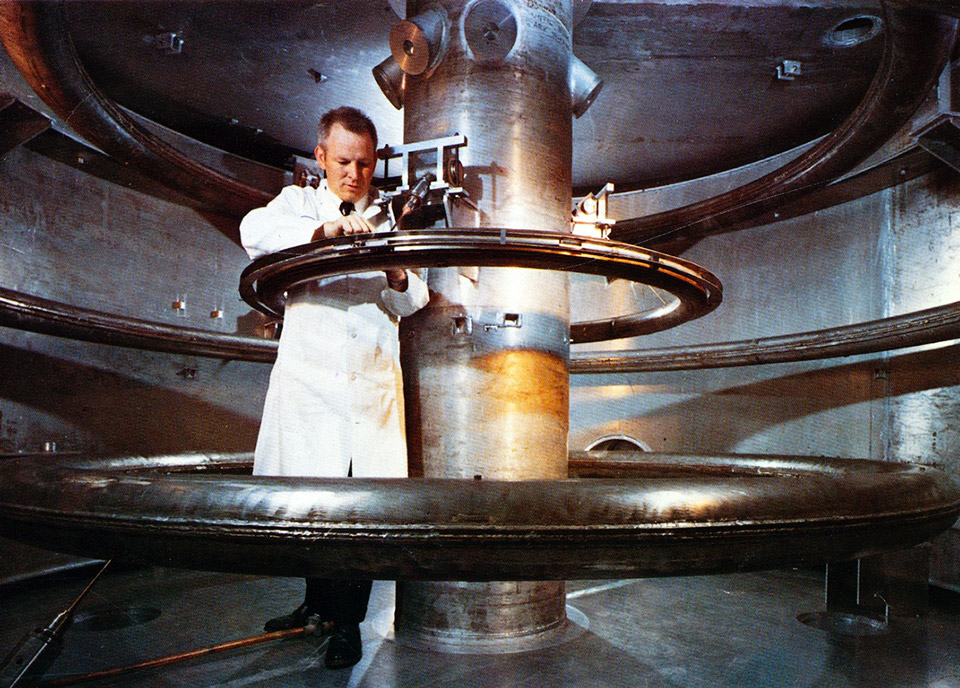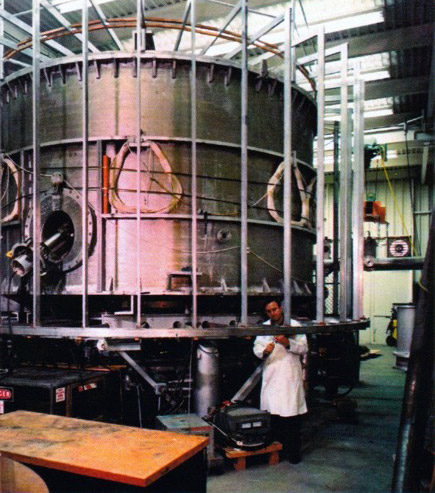Search for the Holy Grail at General Atomics (GA)
After the many departures, Ohkawa took charge of rebuilding the GA fusion program. He sent a proposal for a scaled-up experiment to the Atomic Energy Commission (AEC), and after much debate, the AEC decided to support Ohkawa’s work. [Steve Dean] The objective of the experiment was to demonstrate that plasma could be confined for more than 300 Bohm time, potentially long enough for self-sustaining fusion plasmas.
Ohkawa’s first step was designing and building a large multipole device that was dubbed the “dc Octopole.” It was based on Ohkawa’s observation that conducting the same plasma experiments in a device with a large vacuum chamber would cost less than it would for a small device with strong magnetic field. Two other research groups — a toroidal Octopole under Donald Kerst at the University of Wisconsin, and the Princeton Plasma Physics Laboratory Spherator under Shoichi Yoshikawa — were seeking the same goal, both using stronger magnetic fields and superconducting coils. Ohkawa’s idea prevailed over these competing designs in 1968 when GA became the first group in the world to demonstrate a confinement over 300 Bohm time.
Picture of dc Octopole.
Upper: inside coils.
Lower: outside view with toroidal coils.
Russians called it Tzar Machine because of the size. (The toroidal coils were added later in 1971.)
Ohkawa would later call this experiment his proudest accomplishment. “Looking back, that is the [multipole] experiment I’m most proud of, because that really proved there are such things like classical diffusion, meaning ‘the Holy Grail.’” The experiment’s success, Ohkawa said, “showed the technique would work, and also all the basic theory of plasma transport works when a plasma is quiet and stable.” [AIP Ohkawa interview]
Ohkawa’s concept for the multipole came from the same basic idea as the FFAG. “An FFAG is an overall focused system with a combination of focus and defocus sections. A multipole is an overall stable system with a combination of stable and unstable sections. Later, people called it an averaged minimum B system.” He added, “Careful preparations for the experiments are just applications of early-day training to come up with many ideas.”
In the succeeding years, a number of outside physicists conducted fusion research with Ohkawa and became leaders of fusion society in the world, among them Dale Meade (PPPL), Hiroyuki Ikeji (UCLA), Yasushi Hamada (NIFS), Tatsuoki Takeda (JEARI), Kimita (NIFS), and Sanae-I. Itoh (Hiroshima University).


 < PREVIOUS
< PREVIOUS NEXT >
NEXT >